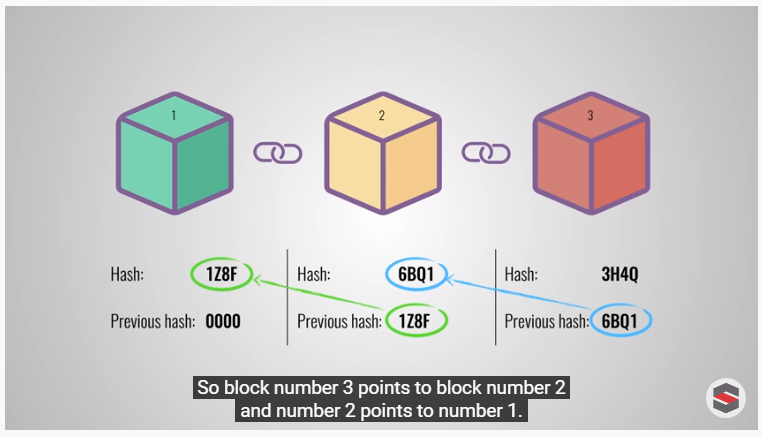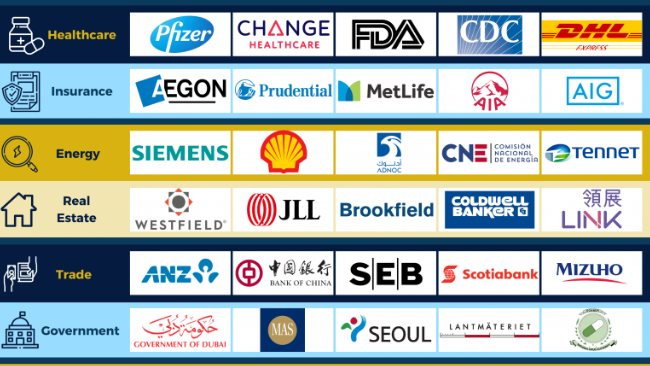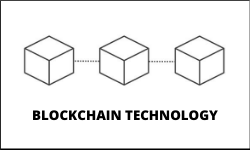This post is all about Blockchain Technology, one of the world’s best innovations.
Most folks today, transfer and store digital assets easily and swiftly using the blockchain technology.
Also, many corporations have integrated or are looking to integrate the blockchain technology into their systems.
But what exactly is the blockchain technology and how does it work?
As you read this post, you will find the answers to these questions and more!
Post Overview
For a comprehensive study of the blockchain technology, I grouped this post under the following subheadings:
- What is Blockchain Technology?
- Bitcoin – The First Ever Use Of Blockchain Technology
- What A Block Is
- How Does Blockchain Technology Work?
- Who Can Use Blockchain Technology?
- FAQs
- Conclusion
A click on any item above will reveal its details.
Let the learning begin!
1. What Is Blockchain Technology?
Firstly, as the name implies, Blockchain is a ‘chain of blocks’, but here we are not referring to your normal brick blocks. (Smiles)
Let’s try and break it down with this simple illustration.
Imagine a special excel spreadsheet that is shared by every computer in the world and connected to the internet.
Every time a transaction happens, it gets recorded onto a row of this spreadsheet.
Anyone with a phone or laptop and with an active internet connection can access this spreadsheet.
Now, anyone can view and add a transaction to the spreadsheet, but cannot change the information that is already there.
This is basically and literally a blockchain. It doesn’t get any simpler.
Summarily:
Blockchain Technology is a decentralized way of maintaining a ledger that is practically impossible to fabricate.
Let’s explain 2 key words from that definition: decentralized and ledger.
Decentralized means there is no one authority in charge of the blockchain. It also means that the blockchain can be accessed by the public.
Ledger is a collection of records.
So we can then say that Blockchain Technology is a way of maintaining a ‘collection of records’ that can be accessed by the public without any restriction from a central authority.
These attributes of the blockchain make it difficult to change any data after it has been recorded.
Hence, every information on a blockchain is totally secure.
Blockchain technology was initially described by a group of researchers in 1991 but it was not used until 2009 when Satoshi Nakamoto adapted it to create Bitcoin.
And ever since, many other cryptocurrencies have been created using the blockchain technology.
Let’s look at the Bitcoin Blockchain – the first application of the blockchain technology.
2. Bitcoin – The First Ever Use of the Blockchain Technology

As mentioned earlier, blockchain technology’s first and still most famous application is Bitcoin.
Bitcoin is a peer-to-peer digital currency for the modern, digital age. It is created and held on the bitcoin blockchain.
The Bitcoin blockchain is a public ledger of all Bitcoin transactions that has ever been executed.
It has complete information on every block beginning from the genesis block to the most recently published block.
It takes about 10 minutes for a new block to be confirmed and added to the blockchain.
The blocks are added to the blockchain in a linear, chronological order. And the blockchain is constantly growing as new blocks are added to it.
Talking about blocks, do you envision those red bricks used while building?
Yeah….Those are blocks too! But the block I mean here is nothing of that sort.
Let’s check out the type of block I am talking about in the next section.
Keep reading!
3. What A Block Is
A block is a file where data pertaining to the network is permanently recorded. It is like a page in the ledger(blockchain).
Every block in any blockchain contains relevant information.
There are 3 major information contained in a block: some data, the hash of the block, and the hash of a previous block.
The data stored inside a block depends on the type of blockchain.
For example, a block in a blockchain developed for funds transfer would contain details like the sender, receiver, and amount of funds.
It is the hash that gives a block its identity/name. The hash of a block is as unique as a fingerprint. Every block has its hash.
In creating a new block, its hash is calculated. Any attempt to change any information in the block will definitely change its hash.
You can trace a block in a blockchain using its hash.
As for the hash of a previous block, it is added to create a link between blocks.
This link is what forms the blockchain.
And the presence of this hash makes it possible for a block to refer to the block before it.
However, the first block in a blockchain lacks this character. It is called ‘genesis block’ and it cannot refer to previous blocks.
Other blocks in a blockchain refer to the blocks before them. And as such, altering the details in a particular block will render the blocks after it, invalid.
This image makes it clearer. Have a look:

You can see that any changes made in block 2 will render block 3 invalid. That is the blockchain for you.
Next, we’ll see how the blockchain technology works.
Read on!
4. How Does The Blockchain Technology Work?
To understand how the Blockchain Technology works, we will use the Bitcoin Blockchain as a case study.
There are two core principles in the Bitcoin blockchain: nodes and proof of work.
Nodes refer to different computers that verify bitcoin transactions before they are added to the bitcoin blockchain.
Each node in the bitcoin network has a copy of its blockchain.
They determine when a new block can be added to the blockchain. And these nodes are located in different parts of the world.
Proof of work is the consensus mechanism employed by the bitcoin blockchain. It involves some form of math equation needed to calculate the target hash of a new block.
Such that when a computer (node) succeeds in the calculation, it sends the result to other computers for confirmation.
Once they confirm the result, the new block is added to the blockchain.
PS: Consensus mechanism is the condition that must be met before each node will agree that a new block can be added to a blockchain).
This is what happens:
When a transaction is sent over the Bitcoin network, it is broadcasted to the nodes for validation.
At this point, the transaction is unconfirmed though valid.
Next, the nodes gather all the unconfirmed transactions into a block and get to work trying to get the new block into the blockchain.
The first node to generate a 64-digit hexadecimal number that is equal or less than the target hash adds the new block to the blockchain.
Now, the transaction has one confirmation.
With time, other blocks are added on top of this block thus increasing the number of confirmations for that transaction.
And so on, the blockchain keeps building.
Got it? I hope so. You can also read our article on Bitcoin mining to get a clearer picture.
Just like the Bitcoin blockchain, other blockchains have their own community of nodes and consensus mechanisms that manage the blockchain.
The Ethereum blockchain also uses the the Proof of Work consensus mechanism.
In the next section, you will learn about other platforms that can maximize the blockchain technology.
Keep reading!
5. Who Can Use The Blockchain Technology?

Any organization that loves the concept of blockchain technology is free to adapt it to its system.
Major platforms that can benefit from the blockchain technology are:
Advertising: with blockchain technology, making and tracking of micropayments (using digital currency) becomes easier.
Logistics: blockchain technology will regulate and simplify administrative work.
Healthcare: Medicare fraud will reduce. Also, health data will remain private and secure (while still connecting medical devices) with the use of blockchain technology.
Music: By employing blockchain technology, artists can be paid directly as fans listen to their music online.
Voting: Blockchain technology when adopted will make tallying of votes more efficient and effective.
It will also make the voting process more easily accessible while enhancing security.
Other platforms that can benefit from blockchain technology are taxes, insurance, and real estate.
Impressively, several corporations have already adopted blockchain technology and they are excelling in it. They include:
- BBVA
- Intesa Sanpaolo
- De Beers
- Unilever
- FDA
- Change Healthcare
- Aegon
- Siemens
- TenneT Ford
- DHL, etc.
6. FAQs
Since the hash is unique to every block, it becomes difficult to tamper with the information on a blockchain.
In addition to hashes, developers design a consensus mechanism that determines when a new block can be added to a blockchain.
The consensus mechanism is different for different blockchains. But the general idea is to delay the amount of time it takes to create a new block.
A blockchain is also secure because it is decentralized.
There can be thousands of nodes scattered all over the globe, belonging to a blockchain network.
Before information on a blockchain can be fabricated, the intruder would have to recompute the consensus mechanism for all the blocks in the blockchain.
Secondly, he will need the support of more than 50% of the nodes in the network.
And this is practically impossible hence the blockchain remains secure as ever.
Not every cryptocurrency has Proof of Work as its consensus mechanism.
DASH and NEO blockchains use Proof of Stake, the Stellar blockchain uses the Stellar Consensus Protocol while IOTA uses the DAG-directed acyclic graph, etc.
Organizations that adopt Blockchain Technology will achieve:
– greater transparency of their transaction histories;
– enhanced security of their records;
– improved means of tracking events;
– higher efficiency and speed in completing transactions;
– a higher reputation for adopting an innovative technology
– reduced costs by getting rid of third parties/central authorities.
The future is very bright for Blockchain Technology.
For instance, the Dubai Government has launched her Emirates Blockchain Strategy 2021 and Dubai Blockchain Strategy to power the country’s core systems.
So, expect a future where transactions in different sectors are easier because of blockchain technology.
7. Conclusion
This is where we will call it a wrap in today’s discussion. You can agree with me that blockchain technology is almost becoming an integral part of our lives.
Want to remain updated? Then subscribe to our newsletter. We promise to send you only relevant stuff.
Before you go, I’d love to hear from you:
What do you think of the blockchain technology?
Do you think more industries will adopt it? If yes, which ones?
Let me know your thoughts (or questions) in the comments section right now.
One more thing, help share the knowledge! Click on the social media buttons below to share this post with friends.
Thank you!
PS: If you want to learn how to trade cryptocurrencies profitably, then enroll in our Crypto Currency Mastery Course by going to www.ctmastery.com. You can also join our Telegram community at https://t.me/ctmastery



More industries and persons should get involved